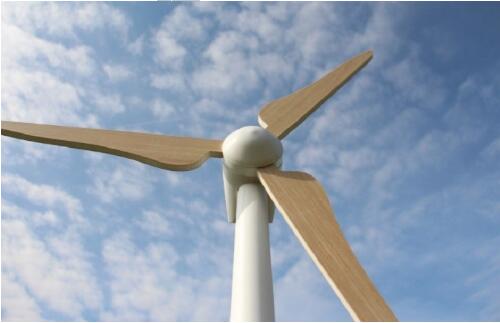Thermoplastic foam - the "slimming" gospel of offshore wind turbines
Legend: Rotor blades made of thermoplastic sandwich material. As offshore wind turbines become larger, transporting, assembling, disassembling and handling such large rotor blades is a major challenge for operators. The highly durable thermoplastic foams and composites developed by Fraunhofer researchers in collaboration with industry experts not only reduce the weight of the blades but also make them recyclable. Due to its special properties, the new materials are also suitable for other lightweight components in the automotive industry. Their first product will be presented at the 2016 Düsseldorf International Plastics and Rubber Expo, October 19-26. , Today, the trend of offshore wind farms becoming more massive has increased. To maximize energy production, wind turbine rotor blades are up to 80 meters in length and rotor diameters over 160 meters. Since the length of the blade is limited by its weight, it is necessary to develop a high-strength lightweight system material. The low weight not only makes the wind turbine easy to assemble and disassemble, it also improves the stability at sea. In the EU's WALiD (significant cost-effective, advanced design of lightweight wind blades), scientists at the Fraunhofer Institute of Chemical Technology (ICT) in Pfinztal work closely with ten industrial and research teams on lightweight rotor blades. the design of. They hope to improve the life of the blade by improving the design and materials to reduce the weight of the blade. Thermoplastics are replacing thermoset materials At present, the rotor blades of wind turbines are mainly hand-made thermosetting resin systems. However, since the material of the system is difficult to melt, the difficulty in material recovery is caused. The best case is simply to recycle the particulate thermoset plastic as a filler for some simple applications. Fraunhofer ICT project coordinator Florian Rapp said: "In the WALiD project, we are pursuing a new blade design. We are realizing the conversion of material categories and using thermoplastic rotor blades for the first time. The thermoplastics have fusibility. Help us to use automated production equipment to effectively process.†Their goal is to separate glass and carbon fiber for reuse of thermoplastic matrix materials. The project team used a sandwich material made of thermoplastic foam and fiber reinforced plastic to make the outer shell of the rotor blade, as well as certain parts of the inner support structure. Generally, the area where the rotor blade is subjected to the maximum load is made of carbon fiber reinforced thermoplastic, and the part with less stress is made of glass fiber reinforced plastic. As for the core of the sandwich, Rapp and his team are developing thermoplastic foams and attaching them to a cover made of fiber-reinforced thermoplastic. Such a combination increases the mechanical strength, efficiency, durability and longevity of the rotor blade. Rapp said: "We are opening up new horizons with thermoplastic foam." New uses for lightweight building materials ICT's thermoplastic foams are superior to existing material systems, making them a new application in the automotive, aerospace and marine industries. For example, the goggles and seats of the vehicle are made of foam, but the load-bearing structure cannot be made of foam. There are some problems with the foam currently on the market. For example, due to the poor thermal stability of the foam, the foam insulation layer is not installed near the engine. Rapp said: "In contrast, our fusible plastic foams are thermally stable and suitable for use as insulation materials close to the engine. They have good high temperature resistance, among them expanded polystyrene foam (EPS) and hair. Polypropylene (EPP) is a good example. The enhanced mechanical properties also make them useful for door modules or as a reinforcing element for sandwich composites. They can be processed quickly and save material. Another advantage is that thermoplastic foams such as cork are more readily available than renewable sandwich core materials. These new materials are made in the foam extrusion plant of the institute. Rapp's explanation of the process is: “After the plastic particles are melted, the blowing agent is mixed into the polymer melt to foam the material. Next, these foamed, stable particles and semi-finished products can be formed and cut as needed.†In the field of foamed polymers, from the development of materials and the manufacture of extruded foam particles and semi-finished products to the completion of process media and components, the ICT foam technology research team covers the entire thermoplastic foam production chain. At the Düsseldorf International Plastics and Rubber Expo, held from October 19th to 26th, 2016, researchers will showcase miniature wind turbines made from new foams and composites. Participants can see the exhibits (Exhibition No. SC01) at Hall No. 7, Fraunhofer.
High Density Fiberboard is well known for its enhancing the interior decoration,especially for commercial use area.
Decorative paper finish and core base material, high density moisture proof board.Compare with traditional wall coverings,it's anti-scratch and waterproof,and most importantly it's easier and cheaper to install than those.It's very popular with global market.
Hdf Wall Panel,Flooring Hdf Panel,Melamine Faced Hdf Board,Wall Panel Cement Boards CHANGZHOU ART DECORATION MATERIALS CO.,LTD , https://www.cnartdecor.com
